
Austria - private operators
For a full scale picture, please click on the picture shown !
Achenseebahn
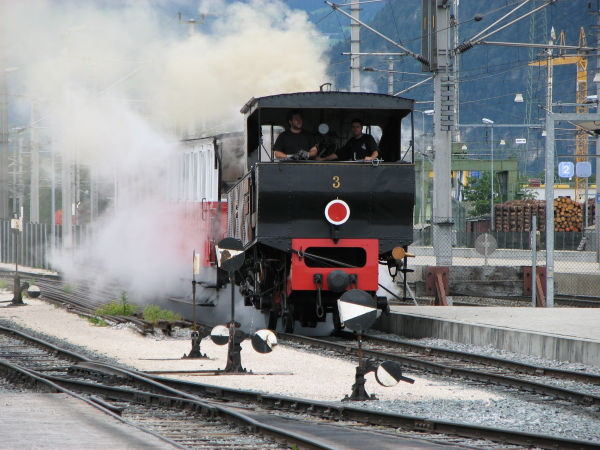
Achenseebahn (Achensee railway) is a 6,8 km long metre gauge alpine railway running from Jenbach high up to Seespitz.
It's a third rail cog railway fitted with the so called Riggenbach system cog wheel rails. It's said to be Europe's
oldest cog railway.
This locomotive no.3 is a 0-4-0RT machine called Achenkirch (church of Achen), also known as Georg. It was built by
the Wiener Lokomotivfabrik in 1889.
Picture from Jenbach 22.7.2007 by Bengt Halme.
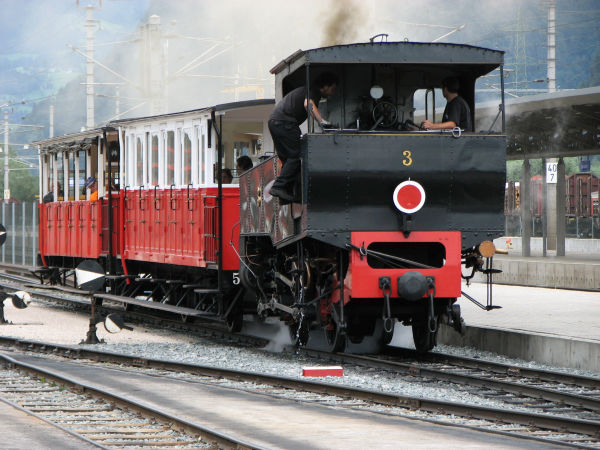
Another view of the same Achenseebahn locomotive no.3 as it arrives at Jenbach.
Picture from Jenbach 22.7.2007 by Bengt Halme.

Closeup view of the same Achenseebahn locomotive no.3.
Picture from Jenbach 22.7.2007 by Bengt Halme.
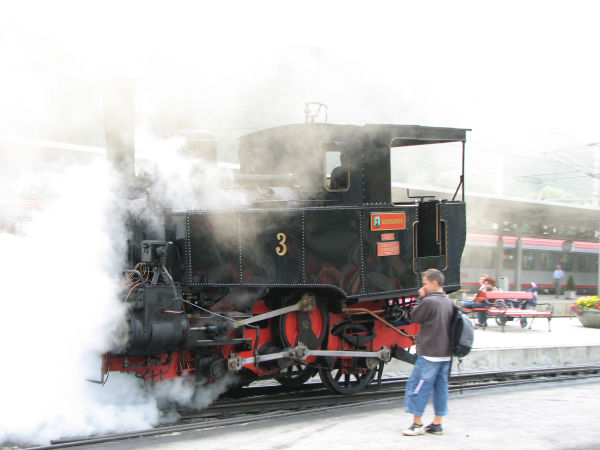
Old steam engines are stinky polluters :-)
Picture from Jenbach 22.7.2007 by Bengt Halme.
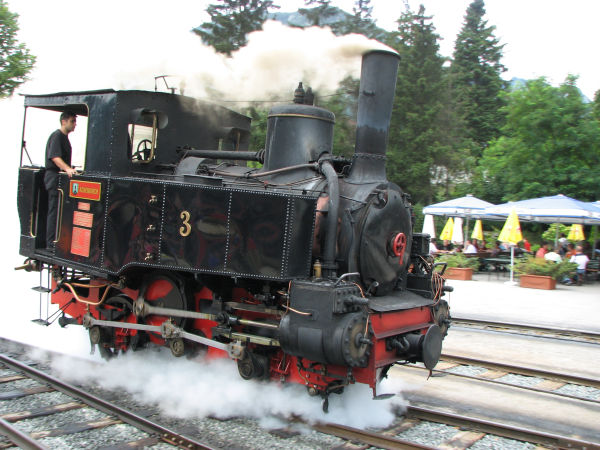
There it goes. Moves like a young lady :-)
Picture from Jenbach 22.7.2007 by Bengt Halme.
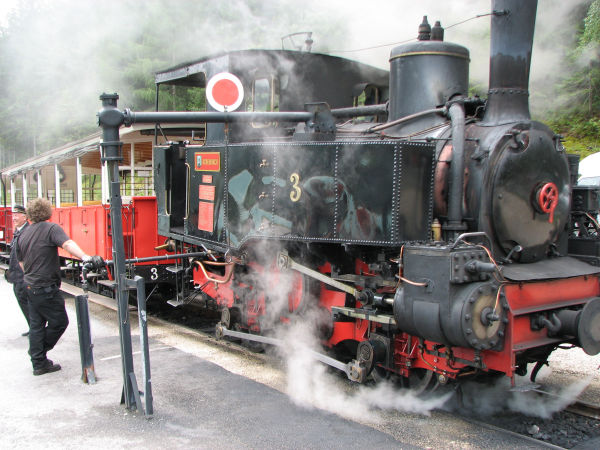
More water.
Picture from Jenbach 22.7.2007 by Bengt Halme.
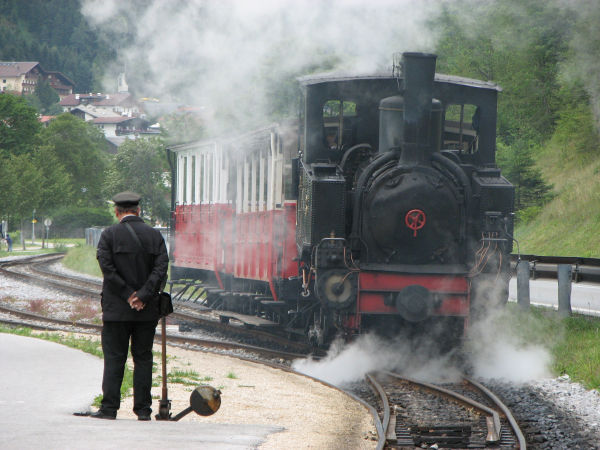
Backing up towards garage.
Picture from Jenbach 22.7.2007 by Bengt Halme.
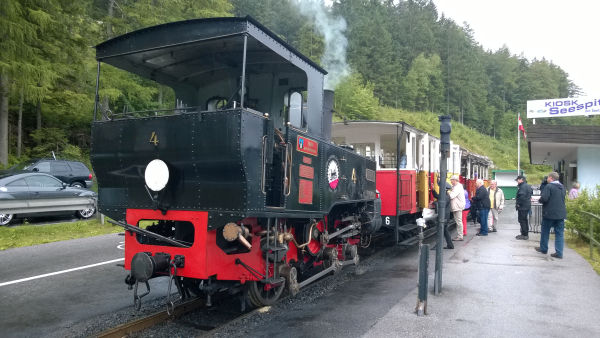
Achernseebahn no.4 loading tourists at the end station Seespitz. Locomotive no.4 "Hannah" is built from scrap parts of sister locomotives.
Wikipedia: "Built using old frames of No.2, mechanism from No.3 and undamaged parts from No.1 and a second-hand boiler from Polandzh.
In service since 2008."
Picture from Seespitz 2.7.2014 by Bengt Halme.
Cargoserv

Private operator Cargoserv's leased locomotive ES 64 U2 (Siemens Eurosprinter 6400kW universal with 2 electric systems) is exactly the
same locomotive as ÖBB's class 1116 Taurus of the second generation. Here it is approaching a road crossing at Ennsdorf 3.1.2003.
Photo by Ilkka Siissalo.
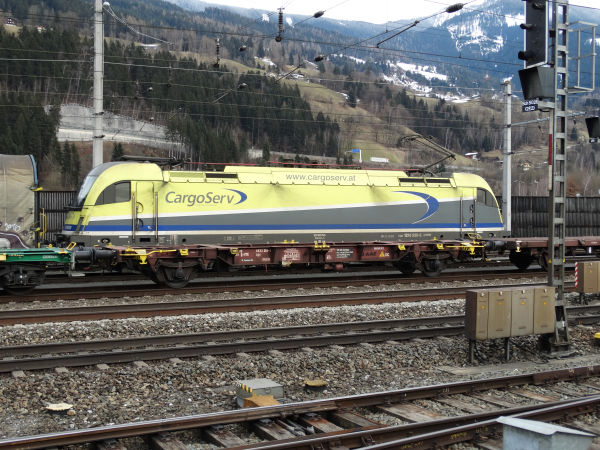
A third generation Siemens Taurus, class Br1216 of Cargoserv waiting at Bischofshofen station.
Picture 14.3.2018 by Ilkka Siissalo.
ecco-rail GmbH
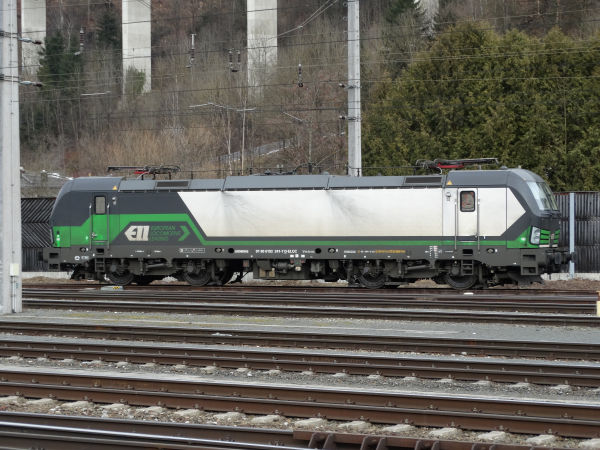
This is a new Siemens Vectron AC, built by Siemens and delivered in December 2015 to the Austrian leasing company European
Locomotive Leasing ELL of Wien. ELL leased it immediately to ecco-rail GmbH of Wien, Austria. The machine's owner and lesser are
both Austrian, but the locomotive is registered in Germany as the Br193 no. 241. It is of the subtype which can operate in
Germany, Austria, Hungary and Romania. Here it is still working for ecco-rail and waiting for its next job at Bischofshofen.
Picture 14.3.2018 by Ilkka Siissalo.
Lokomotion (Lokomotion Austria Gesellschaft für Schienentraktion mbH)
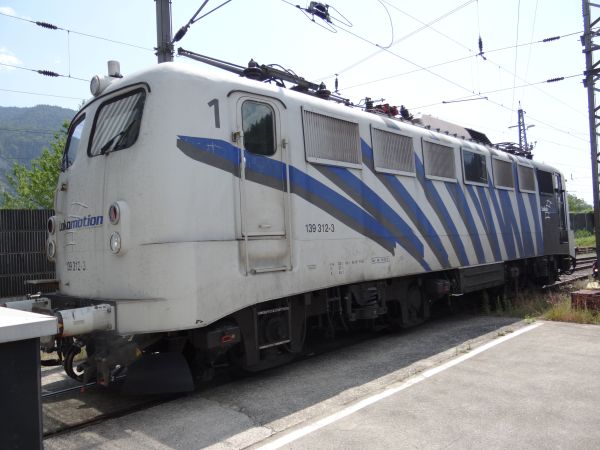
Lokomotion is a company based in Kufstein just on the Austrian side of the German-Austrian border, but as a company it is
active at least in Germany, Austria and Italy, hauling numerous goods trains over the alps, mainly via the Innsbruck-Brenner route.
Lokomotion has some locomotives of its own, such as this old ex-DB Br139, but in addition to those, the company rents
various machines from several locomotive rental companies. Most of the Lokomotions' locomotives have in one form or another
the company's so called "zebra" painting, such as this Br 139 shows, but sometimes the stripes are red or silver or of
some other colour. The company is founded in 2000, with its headquarters in Münchem Germany, but with its operations
centered in Kufstein, Austria. The company says its main business is to haul steel, cars and contaminated earth over the alps.
Picture of Lokomotion 139.312 at its home depot in Kufstein 7.7.2015 by Ilkka Siissalo.
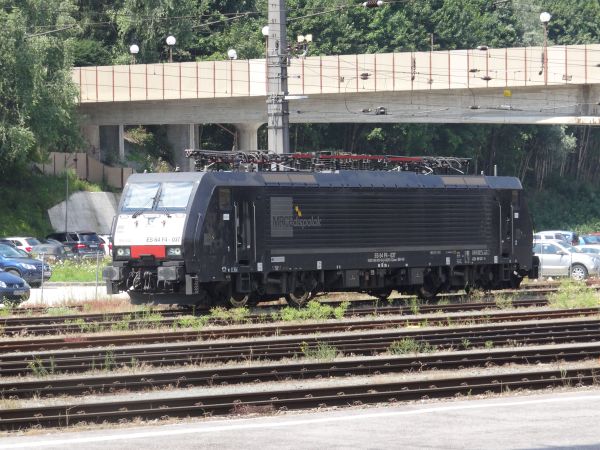
An MRCE locomotive leasing company Br 189 or ES 64 F4 (Siemens Eurosprinter 6400kW freight version with 4 different elecric systems)
locomotive leased by Lokomotion at Kufstein 7.7.2015. The white front signals already from a distance that this machine is intended
for traffic in the Netherlands, so this is one of the few existing ones that can handle the whole route Holland-Germany-Austria-Italy
without the need to change a locomotive. Picture by Ilkka Siissalo.

Another view of the MRCE Br189 locomotive at Kufstein. Note the four different pantographs for the various countries. MRCE as a company
tries to paint its locomotives black. Previously the company was known as Siemens Dispolok and then just Dispolok and by that time
the locomotives had yellow ends. One can still today spot some in that type of livery. This individual was delivered to MRCE in 2009
and was subsequently leased to CTL, boxXpress, OHE and TXL Logistik before the hire to Lokomotion. Picture in Kufsten 7.7.2015 by Ilkka Siissalo.
MBS Montafonerbahn

MBS Montafonerbahn, the Montafon railway, connects the city of Bludenz down in the valley to Montafon. Up till 1972
this normal gauge line was electrified with 800V DC and was in 1972 converted to normal 15kV 16,7Hz. The line is
close to 13 km long and it is today a part of the communal traffic and ticketing system of the area, the VVV
Vorarlberger Verkehrsverbund. The line was opened 1905. MBS operates in addition to the Bludenz-Montafon line
also some trains even to Lindau in Germany, and via Liechtenstein to Buchs in Swizerland, making it occasionally possible for
one to observe MBS' trains in four countries. This train, which the MBS has marked as ET 10 is actually
a Swiss NPZ or Neue Pendelzug, a very common commuter train type in Switzerland in the 1980s and 1990s. This one
is built 1994. Picture at Bludenz station 5.1.2003 by Ilkka Siissalo.

Another view of an MBS NPZ train, this time the ET 10.208, at Bludenz station 5.1.2003 by Ilkka Siissalo.

One of the same NPZ trains of Montafonerbahn, but now photographed 27.1.2013 at Bludenz station by Ilkka Siissalo.
MBS was still using the same rather old trains, but had in the meantime repainted them.
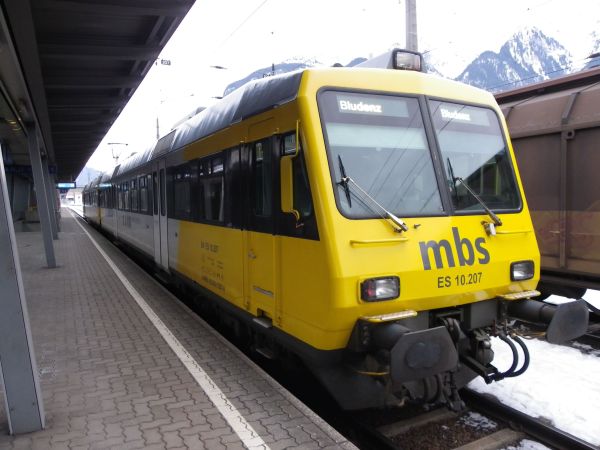
Another view of the same Montafonerbahn NPZ ET10.207. Picture at Bludenz station 27.1.2013 by Ilkka Siissalo.
NÖVOG, Niederösterreichische Verkehrsorganisation Gesellschaft m.b.H, Citybahn Waidhofen an der Ybbs (Ybbstalbahn)
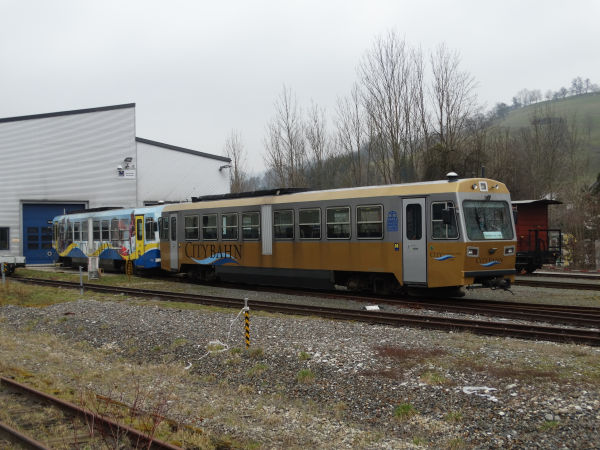
The so called Citybahn or Citybahn Waidhofen an der Ybbs is a narrow gauge line running from Waidhofen at the river Ybbs to Gstadt. This is a mere
5,5 km line. But the original line ran further from Gstadt on to Ybbsitz, another 5,7 km, and another side line to Kienberg-Gaming, 70,9 km away.
All of the line was already planned to be closed down, but today after two unsuccessful attempts to find an operator via public tendering, the
Niederösterreichische Verkehrsorganisation NÖVOG took over the traffic between Waidhofen and Gstadt a couple of times per day. The sidings from Gstadt
to Ybbsitz as well as Gstadt – Lunz am See were inactivated. The remaining 5,5 km are operated by NÖVOG as the Citybahn Waidhofen an der Ybbs, but
there is also a museum train operating in the summertime to Göstling an der Ybbs, 44 km from Gstadt.
The Ybbstalbahn (Ybbs valley railway) is a 760 mm gauge narrow gauge line, operated nowadays by diesels of the former ÖBB class Br5090. There are
five of them left at the Ybbstalbahn, now numbered as NÖVOG VT09, VT10, VT12, VT13 and VT17, all with different colourings. In this picture we see
VT09 (golden, new NÖVOG colouring) and VT10 at the service hall at Waidhofen an der Ybbs.
Picture from Waidhofen an der Ybbs 17.3.2018 by Ilkka Siissalo.
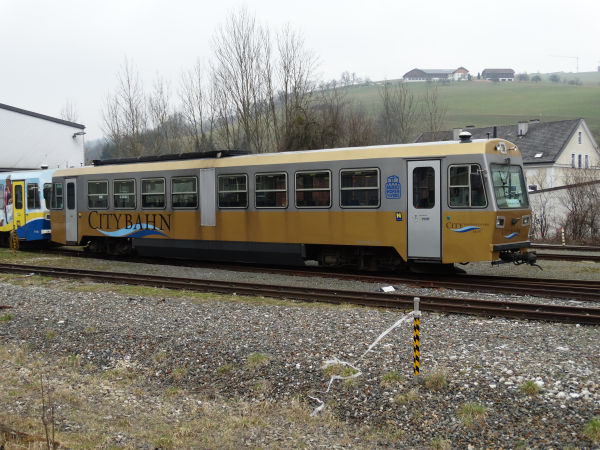
A closer look of the VT09 of Citybahn, a former Austrian state railways BR5090 railbus 5090.09. The VT09 is the first one which has received
NÖVOG's new standard golden livery.
Picture from Waidhofen an der Ybbs 17.3.2018 by Ilkka Siissalo.
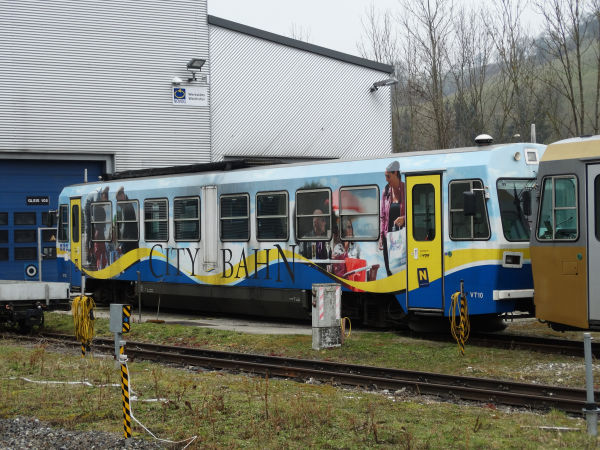
VT10, former ÖBB Br5090.010 is very similar to its sister machines, but has a somewhat older taping as its colouring scheme.
Picture from Waidhofen an der Ybbs 17.3.2018 by Ilkka Siissalo.
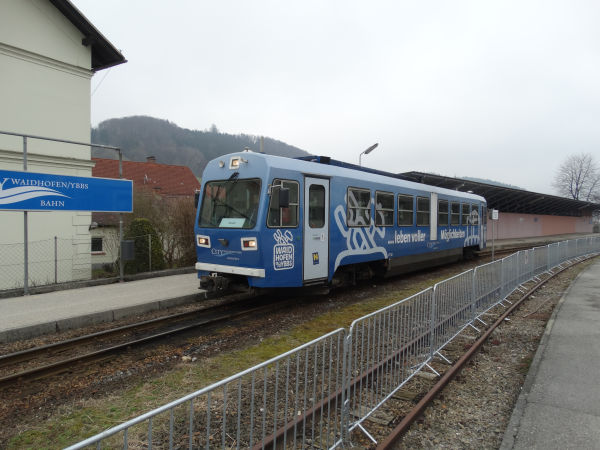
On the day of our visit, VT12 was the railbus doing all the work, pendeling between Waidhofen an der Ybbs and Gstadt.
Picture from Waidhofen an der Ybbs 17.3.2018 by Ilkka Siissalo.
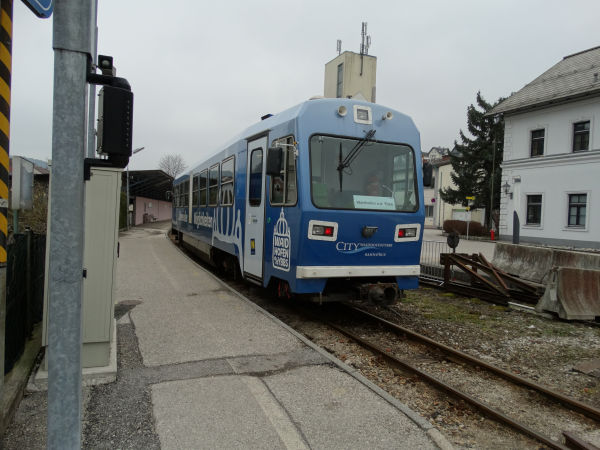
VT12 seen from the other side. The young man who was the driver clearly hated the idea of being photographed. He vanished as soon
as he could, and while doing so, he also turned the text sign the wrong side out, thereby claiming that the train would go to Waidhofen,
although it was already there. Apparently he turned the sign twice. So sorry for making you nervous, pal :-D
Picture from Waidhofen an der Ybbs 17.3.2018 by Ilkka Siissalo.

Some remains from a time long gone by, a conductor wagon of Ybbstalbahn from the steam engine days of ÖBB. Some hobbyists still try to keep
these old museum wagons and engines in running condition.
Picture from Waidhofen an der Ybbs 17.3.2018 by Ilkka Siissalo.
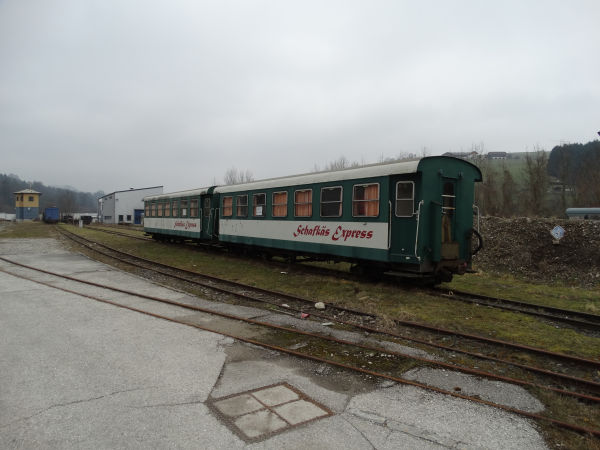
An association of railway hobbyists trying to save the old Ybbstalbahn locomotives, coaches and track had bought these two old Ybbstalbahn
coaches as well as some cargo wagons and were using these as their clubhouse, having marked these coaches as "Schafkäs Express", goat cheese
express. The real operator NÖVOG had however made certain that these wagons have no way of getting onto the real tracks by placing a huge heap
of sand deliberately on the tracks and removing parts of the tracks, so that these wagons are now isolated from the line itself.
Picture from Waidhofen an der Ybbs 17.3.2018 by Ilkka Siissalo.
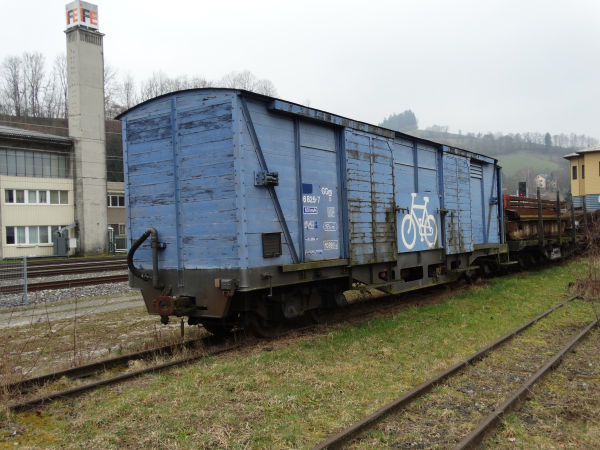
The owners of the "Schafkäs express" coaches also have an old ex-ÖBB narrow gauge cargo wagon of the former ÖBB class GGm, formerly used as a
bicycle transportation wagon on the Ybbstalbahn, now being used as their equipment store. Apparently they are trying to repair an old steam
engine of the former Ybbstalbahn.
Picture from Waidhofen an der Ybbs 17.3.2018 by Ilkka Siissalo.
NÖVOG, Niederösterreichische Verkehrsorganisation Gesellschaft m.b.H, Mariazellerbahn
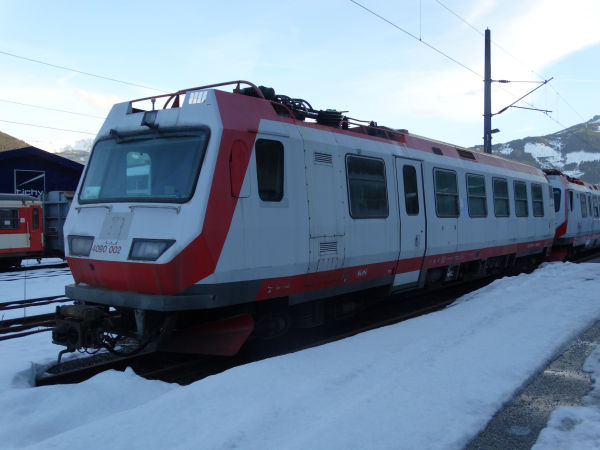
NÖVOG is a public transport operator, owned by the provincial government of Lower Austria. It runs the service of
a number of regional and heritage railways, some cable car lifts and a bus company. NÖVOG operates Mariazellerbahn,
Waldviertelbahn, Wachaubahn, Reblaus Express, Citybahn Waidhofen, Schneebergbahn, Gemeindealpe Mitterbach,
Wunderwiese, Schneeberg Sesselbahn and Wieselbus.
This train is a former ÖBB, later NÖVOG Br 4090 narrow gauge electric multiple unit. They used to run on the Mariazellerbahn.
Mariazellerbahn is a 760 mm narrow gauge railway, 91 km long, which runs from the city of St. Pölten to Mariazell,
a pilgrimage town high up on the Alps. Traffic on the line started 1898-1907. For over 100 years now the line has
been electrified with a quite special voltage of 6,5 kV 25 Hz AC. These electric multiple units were delivered in 1995.
In 2010 NÖVOG took over Mariazellerbahn from state ÖBB and began to modernise it, also ordering new trains from Stadler
of Switzerland to replace these. These Br4090 trains were never a succcess and they were only used for some five years.
The train was a three coach construction with only one of the coaches powered. This picture shows two of the Br4090
motorised coaches. There were multiple problems with the trains all the time, one of them being their modest weight.
There are often heavy winds at the Mariazellerbahn and winds could derail these trains. ÖBB tried to put 4 tons of ballast
weight into them as a countermeasure, but that made the trains lousy in acceleration. They soon got the nickname "Stehzüge",
still standing trains.
Picture from Tischlerhäusl 14.3.2018 by Ilkka Siissalo.

Two Br4090 motorised end wagons and one steering cab wagon.
Picture from Tischlerhäusl 14.3.2018 by Ilkka Siissalo.

A closeup view of Br4090 no.003 motorised wagon.
Picture from Tischlerhäusl 14.3.2018 by Ilkka Siissalo.
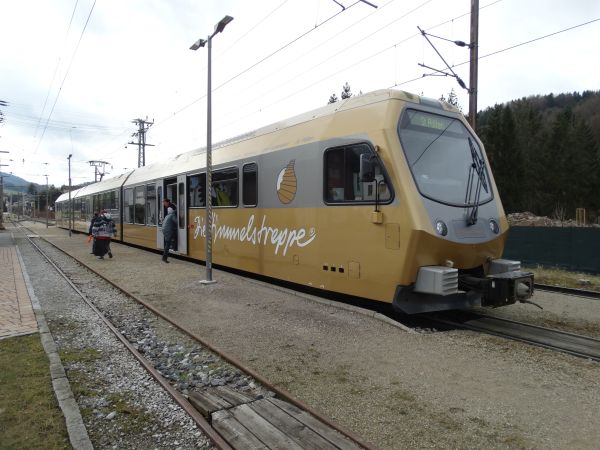
These are the trains that operate on Mariazellerbahn today. This train, known by the name Die Himmelstreppe (stairs to heaven) is built by Stadler
of Switzerland. The model is based on some earlier Swiss narrow gauge models, but is specifically modified for the circumstances at the Mariazellerbahn,
for example to work well in the extremely narrow tunnels with steep curves. Normally the Himmelstreppe trains are three coach combinations like here,
but it is possible during the touristic high season to add one or two extra coaches in the middle of the train. These extra ones are of first class
and they have very large windows even onto the roof to enable rich tourists to view the beautiful mountainous landscape.
Picture from the Rabenstein am Pielach station 16.3.2018 by Ilkka Siissalo.
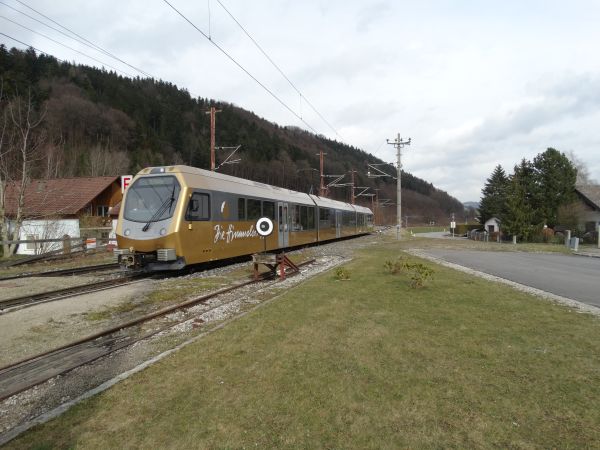
The same Die Himmelstreppe train as in the picture above, here just leaving towards the city of St. Pölten.
Picture from the Rabenstein am Pielach station 16.3.2018 by Ilkka Siissalo.
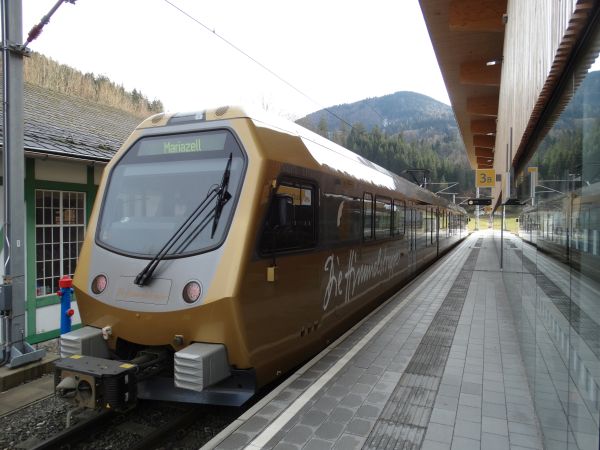
Another one of the new Die Himmelstreppe trains, here stopping at the Laubenbachmühle station.
Picture 16.3.2018 by Ilkka Siissalo.

A view through a window of Mariazellerbahn's service hall at Laubenbachmühle shows two of the extra first class coaches with large panorama windows even on
their roofs. These can be used as extra extension coaches during high season times of the Die Himmelstreppe trains.
Picture from Laubenbachmühle 16.3.2018 by Ilkka Siissalo.
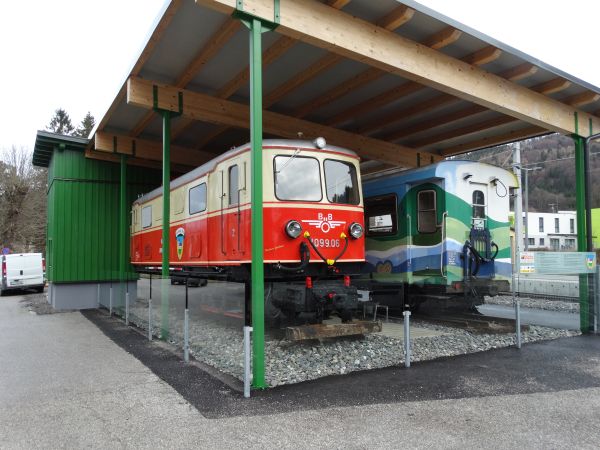
This locomotive is a famous cult engine. When Mariazellerbahn was electrified in 1911, these were the first electric locomotives that were taken in use.
This one, Br1099 no. 06 was in daily use for almost 102 years until finally new Stadler "Himmelsteppe" trains replaced it. As such, this machine is a world
record electric locomotive: no other machine has ever been in continuous active use for a longer time than this one. Now it is set up as a monument.
Picture from Kirchberg am Pielach station 16.3.2018 by Ilkka Siissalo.

Another view of the same ÖBB Br1099.06 world record locomotive. It looks quite modern, especially to think that it was already 107 years old when this
picture was taken. There is a small Mariazellerbahn museum and a model railroad at the Kirchberg am Pielach station.
Picture from Kirchberg am Pielach station 16.3.2018 by Ilkka Siissalo.
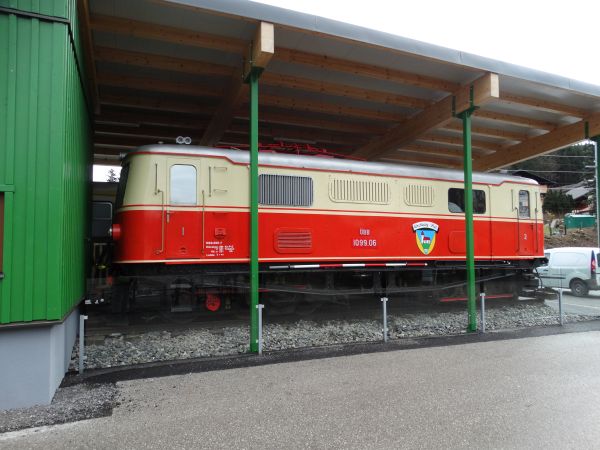
Still a side view of the same locomotive as above. The Austrian model train company Roco has made 1:87 (H0) scale model trains of these famous locomotives.
Picture from Kirchberg am Pielach station 16.3.2018 by Ilkka Siissalo.
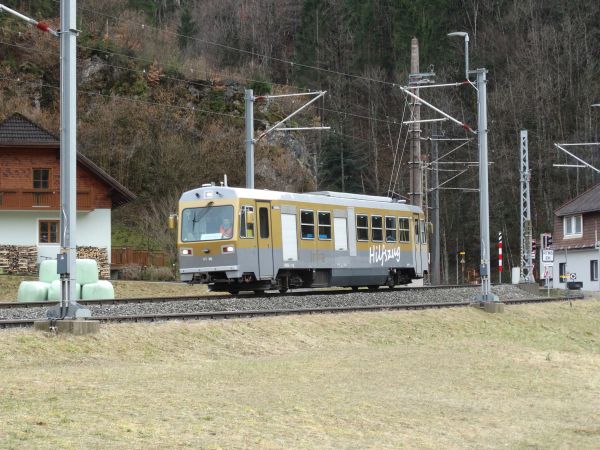
The NÖVOG train VT16 is a former ÖBB class Br5090 narrow gauge diesel railbus, which has now been refitted as a "Hilfszug", helper or relief service train
of Mariazellerbahn Infra.
Picture from Laubenbachmühle 16.3.2018 by Ilkka Siissalo.
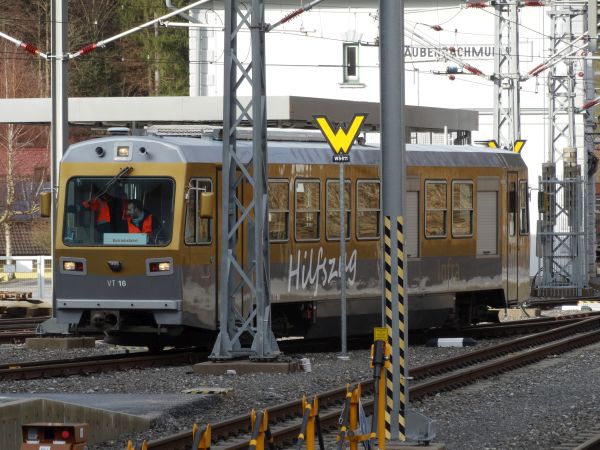
Another view of the same helper diesel railbus, here driving into the garage of trains. Laubenbachmühle is the center of operations at Mariazellerbahn, where NÖVOG
repairs and services the trains and where most of the tourist buses also head to learn about this exotic alpine railway.
Picture from Laubenbachmühle 16.3.2018 by Ilkka Siissalo.
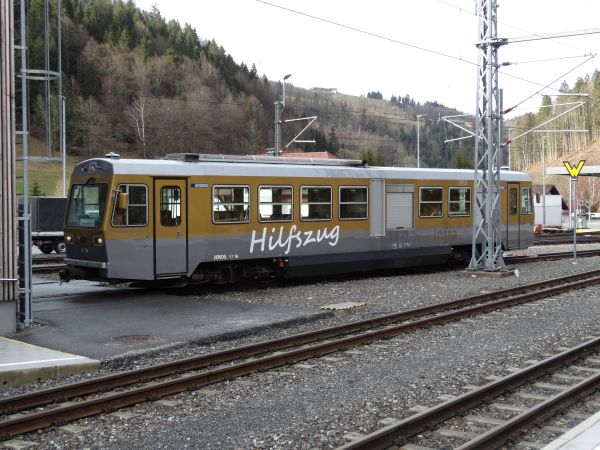
Side view of the same ex-Br5090 railbus, now helper train VT16.
Picture from Laubenbachmühle 16.3.2018 by Ilkka Siissalo.
SLB Salzburger Lokalbahn (now part of Salzburg AG)

An old electric shunter locomotive E 62 of Salzburger Lokalbahn SLB. This is a Bo'Bo' locomotive built by SGP, Siemens and Elin in 1952. Four
locomotives were built (numbers E 61 - E 64). Picture by Ilkka Siissalo at Salzburg Itzling SLB private
station 6.7.2015 by Ilkka Siissalo.

Not much has changed, it's still there. Only SLB is now part of Salzburg AG, so the text tapings at the fronts and sides have been slightly
modified accordingly. SLB E62 at Salzburg Itzling 14.3.2018. Picture by Ilkka Siissalo.

SLB locomotive 83 is an old German DB class 211, ex V 100 of West Germany. Picture at Salzburg Itzling station
6.7.2015 by Ilkka Siissalo.
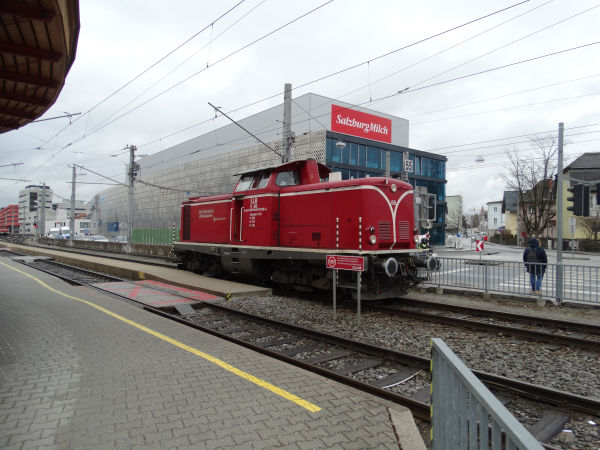
SLB locomotive V86 is also one of the old V100 locomotives (later known as DB Br211 to Br213) of the West German Deutsche
Bundesbahn. This one was built by MaK in Kiel in 1962 and it was formerly DB's locomotive 211 100-3 and later ÖBB's 2048 004-2.
It has nowadays a Caterpillar's 12 cylinder 4-stroke diesel producing 810 kW. Top speed is 100 km/h. SLB has six of these,
numbered V82 to V87.
Picture at the Salzburg-Itzling station 14.3.2018 by Ilkka Siissalo.
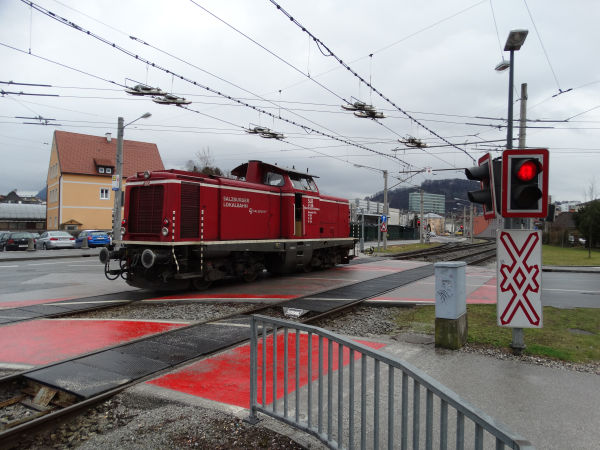
The same SLB locomotive V86 seen from another side.
Picture at the Salzburg-Itzling station 14.3.2018 by Ilkka Siissalo.
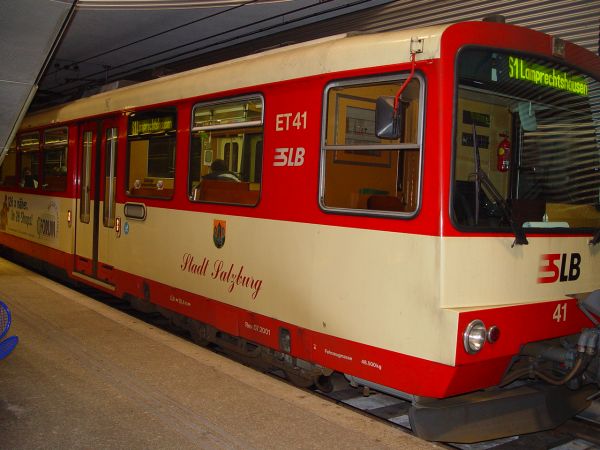
Salzburger Lokalbahn SLB operates in Salzburg a service, which under the downtown works much like a metro, albeit with overhead
catenary wire electricity. Outside the city center the trains are like any local commuter trains. This one is the SLB unit ET41
underground by the Salzburg central station 3.1.2003. Photo by Ilkka Siissalo.
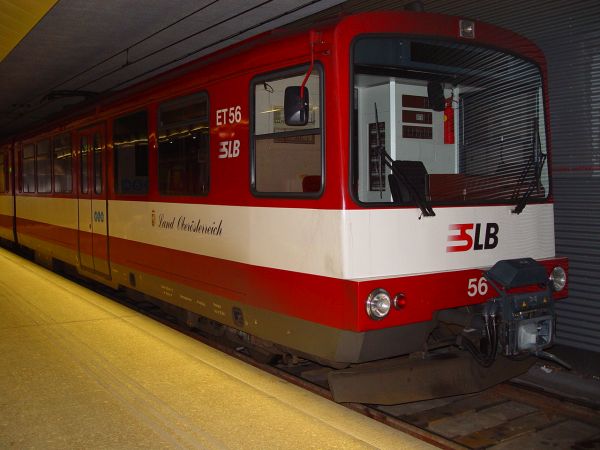
Salzburger Lokalbahn SLB unit ET56 underground by the Salzburg central station 3.1.2003. Photo by Ilkka Siissalo.
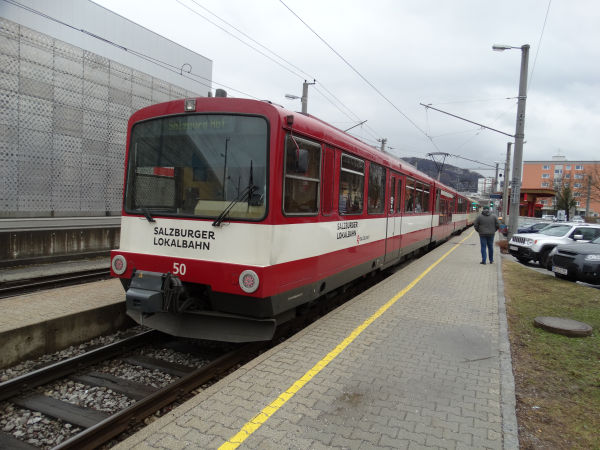
Salzburger Lokalbahn SLB unit ET50 at the Salzburg Itzling station. Compare with the picture above: In a recent modernisation the train
has received in the middle a new low-floor coach. Also its lamps are now new LED lamps.
Picture from Salzburg Itzling 14.3.2018 by Ilkka Siissalo.
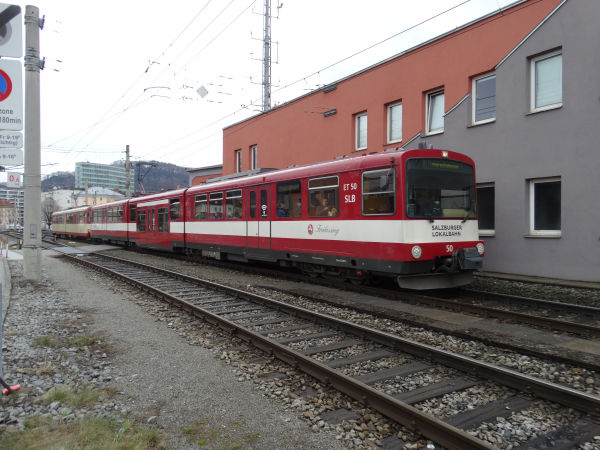
The same train as in the picture above, but now coming back from Salzburg Hauptbahnhof. The three coach unit now at the front is marked
SLB ET50 - note the new third or middle coach with a low-floor compartment, which is here better to be seen - and another unit painted in wine red
and creme and marked as SVB 42. SVB stands for Salzburger Verkehrsbetriebe, the communal traffic (or bus) company of the city. Today both
SVB and SLB are a part of Salzburg AG, the communal company taking care of not only traffic, but also many other things like garbage
collection etc. A long time ago, before using the name Salzburger Lokalbahn, all these trains were marked as belonging to the SVB, so this
creme and red is merely a very old painting scheme. Note by the way, that the trains are running here on the left hand side track. This is
not the case on ÖBB tracks in Austria and it looks like, this is not the rule even on SLB tracks.
Picture from Salzburg Itzling 14.3.2018 by Ilkka Siissalo.

Still the same train as in pictures above, but from this side it's easier to see the unit ET42 which still bears the old SVB markings
and the old red and creme painting. It also lacks the third middle coach with the low floor section. Compare with ET41, which is shown
in one of the pictures above. Unit ET41 has folding doors typical of Düwag trams, whereas none of the other units have them. On the other
hand unit ET41 had already in 2003 SLB markings and not the SVB ones.
Picture from Salzburg Itzling 14.3.2018 by Ilkka Siissalo.
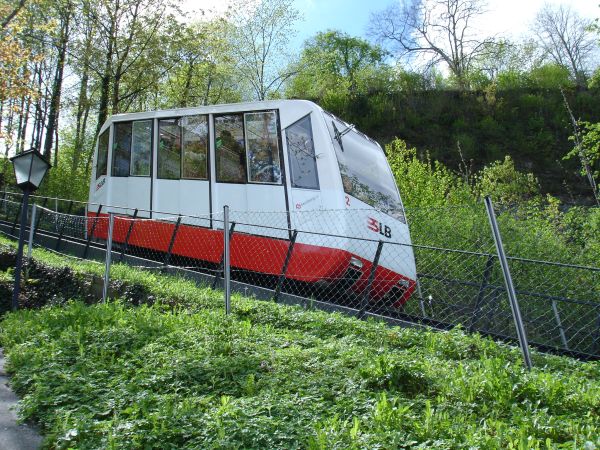
Salzburger Lokalbahn SLB also operates a funicular which runs steeply from the old town up to a castle on top of the hill. Photo of the
funicular's coach no.2 30.4.2006 by Ilkka Siissalo.

The Salzburger Lokalbahn SLB unit ET32 is nowadays only used in special museum trains. It was built by SGP (Simmering-Graz-Pauker) and ÖSSW
in 1951 for use under 1000V DC. There were two similar wagons, ET31 and ET32. They were in 1991 sold to Stern & Hafferl, which used them in
the traffic of LILO, the Linzer Lokalbahn. In 2006 Salzburger Lokalbahn bought this one back, repaired and repainted it in its old style.
During the time when many of SLB's normal trains were out of use due to modernisation efforts, this old wagon was even used as an addition
in normal daily traffic, but currently it is only used in historic trains.
Picture from Salzburg Itzling station 14.3.2018 by Ilkka Siissalo.

The Salzburger Lokalbahn SLB tram-train ET3 is from times long gone. It was built by MAN and ÖSSW in 1908. Similar wagons were ordered both
for the Salzburger Eisenbahn- und Tramwaygesellschaft (SETG) and the Königlich Bayerische Staatseisenbahnen (K.Bay.Sts.B.; Royal State
Railways of Bayern) for their traffic on the line Salzburg–Berchtesgaden–Königssee so that they would have similar rolling stock. This one,
ET3 was still in passenger use until late 1960s and was then converted into a service train. But in the 1980s there was a rapid rise in people's
wishes for oldtimer historic nostalgy rail runs, so it was decided that the old tram-train should be renovated back to its former state. The
first renovation was ready in 1983 and a second one in 2000. In year 2000 the train was put back into its original state of the times of the
SETG as far as it was possible.
Picture from Salzburg Itzling 14.3.2018 by Ilkka Siissalo.
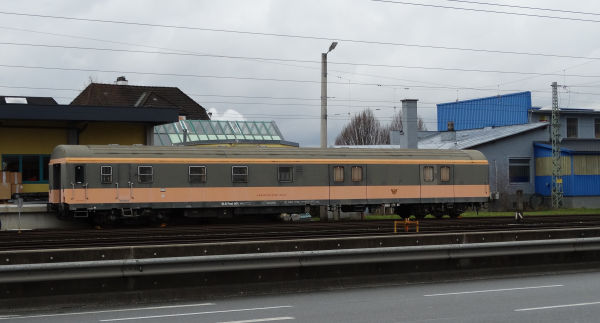
In addition to the local, metro-like traffic around Salzburg, SLB has also extensive cargo services covering regularly not only almost
all of Austria, but also large areas of Germany, even up to Hamburg. They also have their own modern postal wagon, something that not even
the state railways of most countries have anymore.
Picture of "SLB Post 401" at Salzburg Itzling station 14.3.2018 by Ilkka Siissalo.

SLB G601 is just one of the many of SLB's own cargo wagons.
Picture from Salzburg Itzling station 14.3.2018 by Ilkka Siissalo.
Pinzgauer Lokalbahn (a part of Salzburger Lokalbahn SLB / Salzburg AG) / Pinzgaubahn / Krimmler Bahn
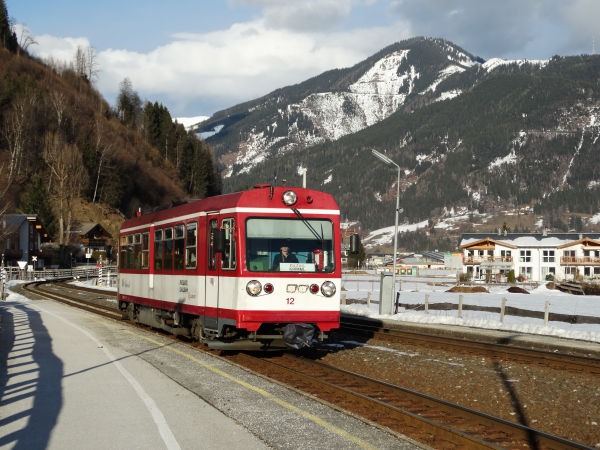
Pinzgauer Lokalbahn is a narrow gauge railway system between Krimml and Zell am See. It has now only for a short time been organisationally
part of Salzburger Lokalbahn SLB and/or its owner Salzburg AG. The line is 52,7 km long and its gauge is 760 mm. Trains are diesel driven.
This one is their railbus VTs 12, built in 1986, former state railways ÖBB 5090.002. It has been at the Pinzgauer Lokalbahn since 2008.
This train was their "express train" service Zell am See - Krimml, photographed at the Bruckberg Golfplatz stop close to Zell am See.
This train did not stop here.
Picture at Bruckberg Golfplatz station 14.3.2018 by Ilkka Siissalo.

Same express train to Krimml is here passing the station of Bruckberg Golfplatz without stopping. It may be an express train, but fast it is not :-)
Picture at Bruckberg Golfplatz station 14.3.2018 by Ilkka Siissalo.
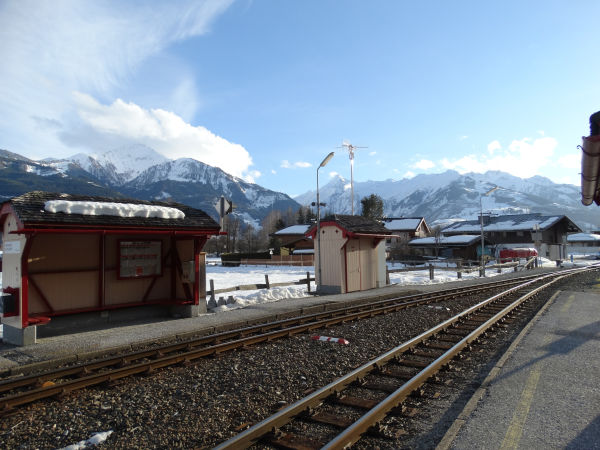
Bruckberg Golfplatz station by the Pinzgauer Lokalbahn. Cute, isn't it?
Picture at Bruckberg Golfplatz 14.3.2018 by Ilkka Siissalo.
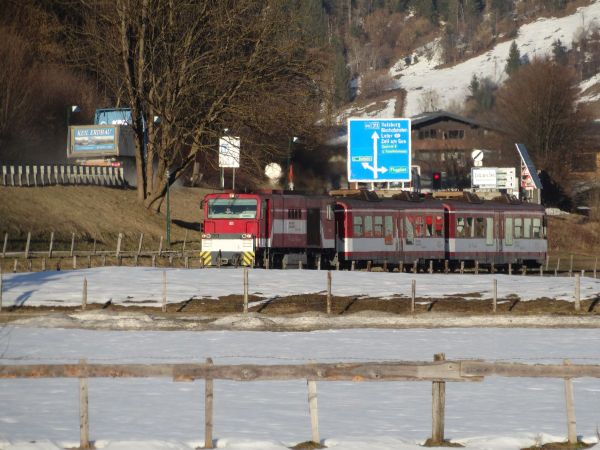
A regular Pinzgauer Lokalbahn train between Zell am See and Krimml, here approaching the train stop Zellermoos at Bruckberg close to Zell am See.
The lokomotive no.81 is a huge Gmeinder machine and the partly low-floor coaches are new.
Picture at Zellermoos by Zell am See 14.3.2018 by Ilkka Siissalo.
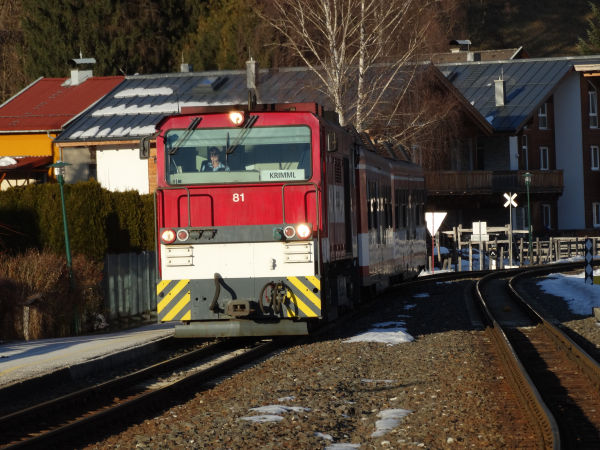
Same train as above, now approaching Bruckberg Golfplatz station.
Picture at Bruckberg Golfplatz 14.3.2018 by Ilkka Siissalo.
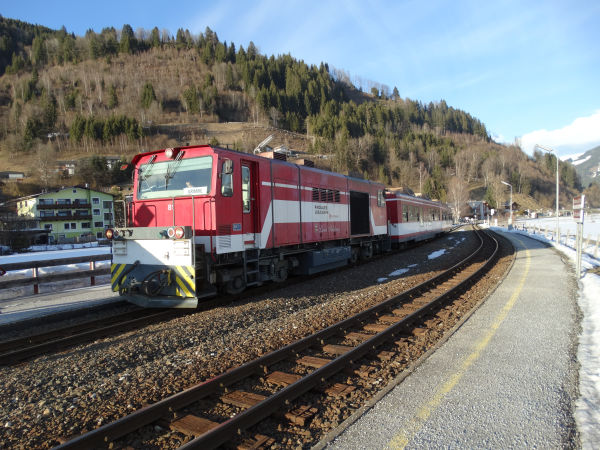
Same train as above. Pinzgauer Lokalbahn has three of these huge Gmeinder loocomotives in normal use.
Picture at Bruckberg Golfplatz 14.3.2018 by Ilkka Siissalo.
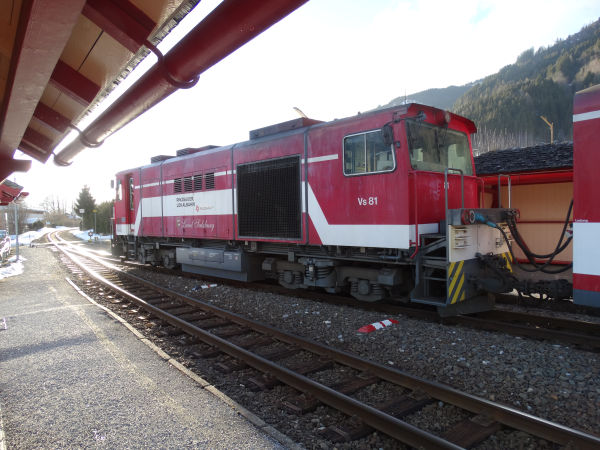
Same locomotive as above, but seen from its side.
Picture at Bruckberg Golfplatz 14.3.2018 by Ilkka Siissalo.
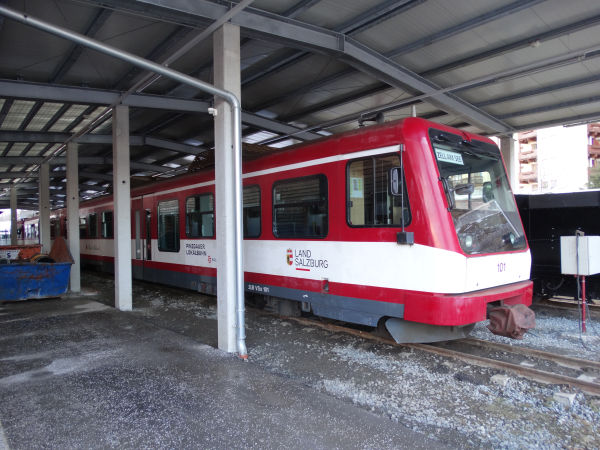
This kind of fixed, new low-floor coach sets are now normal in the traffic of Pinzgauer Lokalbahn.
Picture from SLB depot at Tischlerhäusl by Zell am See 14.3.2018 by Ilkka Siissalo.
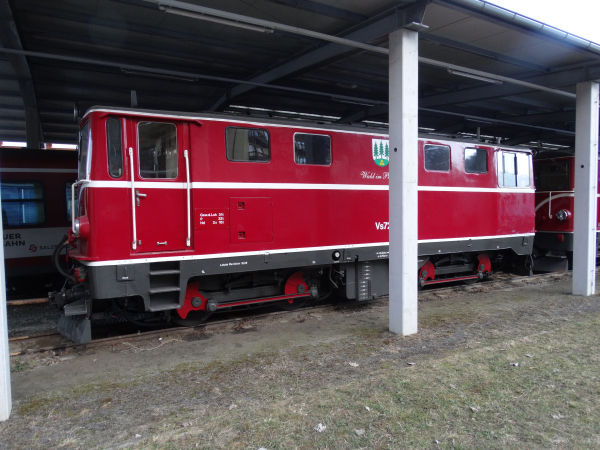
Pinzgauer Lokalbahn's diesel locomotive Vs72. SLB has three of these old diesel machines at Pinzgauer Lokalbahn. They were formerly
state railways ÖBB's class Br2095, built by Simmering-Graz-Pauker 1958-62. Top speed is 60 km/h and its power rating is 440 kW.
Today these are normally only used in shunting at Tischlerhäusl depot and in snow removal duties.
Picture from SLB depot at Tischlerhäusl by Zell am See 14.3.2018 by Ilkka Siissalo.

A similar diesel like the one pictured above, but this one has been thoroughly renovated and put back into its original shape and
paintings of 1958. This is the Br2095 no. 01. Altogether 15 of these machines were built. Pinzgauer Lokalbahn has still three,
some have ended up at NOVÖG, the Niederösterreichische Verkehrsorganisation and two have even been sold to Romania.
Picture from SLB depot at Tischlerhäusl by Zell am See 14.3.2018 by Ilkka Siissalo.
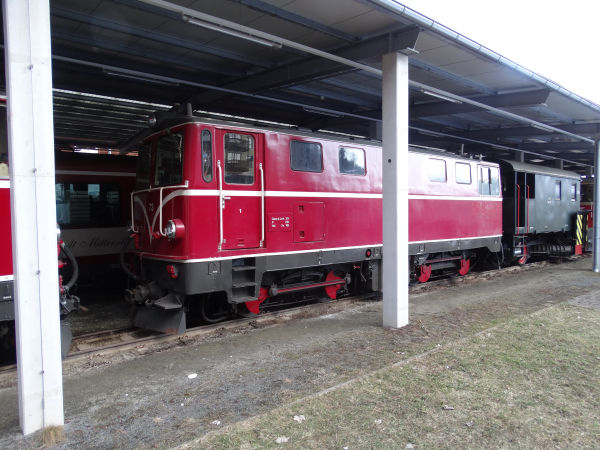
One of the three ex-Br2095s, the Vs73 is here seen with an old mechanical rotating snow plough.
Picture from SLB depot at Tischlerhäusl by Zell am See 14.3.2018 by Ilkka Siissalo.

Detail view of the old rotating snow blower Xs92. It has no engine of its own. Note how its wheel is covered by rubber to
enhance friction. Movement of the axle drives the snow blowing mechanism.
Picture from SLB depot at Tischlerhäusl by Zell am See 14.3.2018 by Ilkka Siissalo.

Old cargo wagons of the Pinzgauer Lokalbahn.
Picture from SLB depot at Tischlerhäusl by Zell am See 14.3.2018 by Ilkka Siissalo.

Old passenger wagons of the Pinzgauer Lokalbahn. Today these are still used in touristic special trains during summer season.
Picture from SLB depot at Tischlerhäusl by Zell am See 14.3.2018 by Ilkka Siissalo.
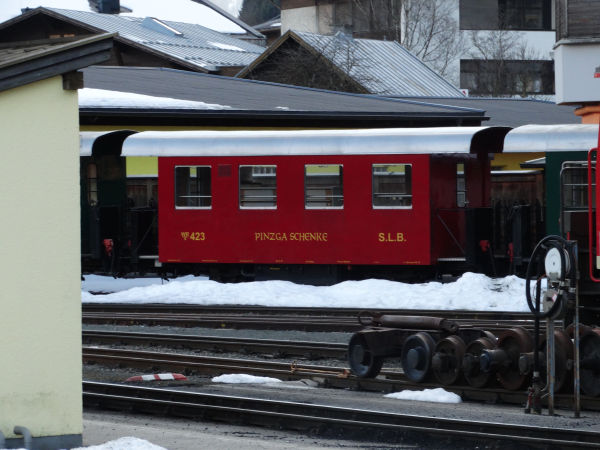
Bar wagon "Pinzga Schenke" of touristic trains.
Picture from SLB depot at Tischlerhäusl by Zell am See 14.3.2018 by Ilkka Siissalo.

Old coaches of the Pinzgauer Lokalbahn.
Picture from SLB depot at Tischlerhäusl by Zell am See 14.3.2018 by Ilkka Siissalo.

These old ex-ÖBB coaches are still in use in historic tourist trains.
Picture from SLB depot at Tischlerhäusl by Zell am See 14.3.2018 by Ilkka Siissalo.
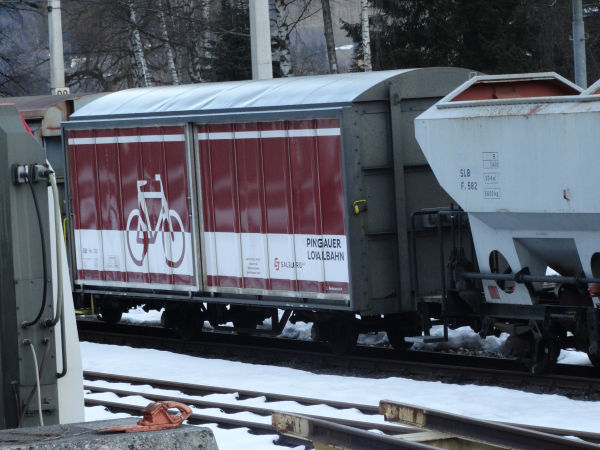
There are also specialised cargo wagons for transporting tourist's bikes. These regularly form a second train which is following the regular
passenger service train. For these bike transportation trains Pinzgauer Lokalbahn still uses the old V72-Vs74/Br2095 diesel locomotives.
Picture from SLB depot at Tischlerhäusl by Zell am See 14.3.2018 by Ilkka Siissalo.

A special train for biker tourists: three bike transportation coaches and a long rake of old ex-ÖBB passenger coaches
Picture from SLB depot at Tischlerhäusl by Zell am See 14.3.2018 by Ilkka Siissalo.
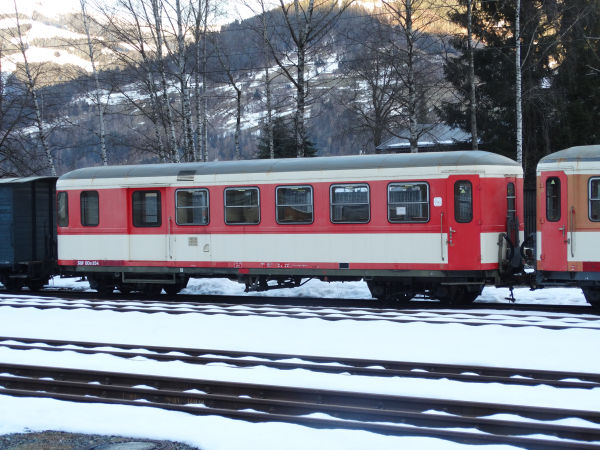
End coach for biker tourist trains: an old ex-ÖBB coach with a conductor compartment at one end. By the way, these coaches can
also be bought as H0 scale model train wagons.
Picture from SLB depot at Tischlerhäusl by Zell am See 14.3.2018 by Ilkka Siissalo.
Steiermarkbahn

Steiermarkbahn Transport und Logistik GmbH is an Austrian open access rail operator which has its headquarters in Graz. They have
two Br1216 third generation Taurus locomotives (here is one), one old German V100 diesel shunter plus rented machines such as the
Siemens EuroSprinter ES64F4 (equal to the German class Br189). As you can see from the picture, this machine is registered in German
register as Br183 but it is the same type which in Austria is usually called Br1216, a third generation Taurus with four electric
systems. These are very versatile machines, which can run even in places like Slovenia or Italy. Steiermarkbahn has two of them.
Picture from Bischofshofen station 14.3.2018 by Ilkka Siissalo.
Stern & Hafferl, Attergaubahn / Lokalbahn Vöcklamarkt - Attersee
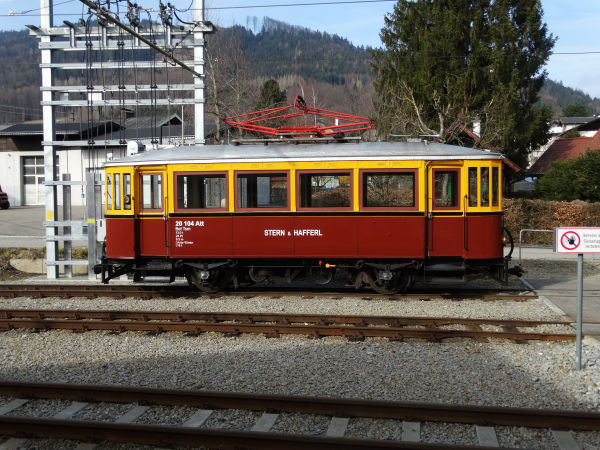
The company Stern & Hafferl owns several private railroads in Austria, some normal gauge, some narrow gauge. The company is well known since
decades for buying very cheaply very old used trams and trains not only from Austria but from neighbouring countries as well and using them
until they are real vintage stuff. Stern & Hafferl has today the following services:
- LiLo, Linzer Lokalbahn; local services around the city of Linz
- Attergaubahn, a metre gauge line between Attergau and Attersee
- Vorchdorferbahn, a normal gauge line between Lambach and Vorchdorf
- Traunseebahn, a narrow gauge line between Vorchdorf and Gmunden
- Gmunder Strassenbahn, a tram service around Gmunden.
- as well as ship services on the Attersee lake.
This is from the Attergaubahn, a small railroad also known as the Lokalbahn Vöcklamarkt–Attersee. It's a
metre gauge local railroad electrified with 750 V DC connecting the main railroad line Wien-Linz-Salzburg to the town of Attersee by the lake
bearing the same name. It was originally a tram line along the lake's shores, which in 1907 was converted into a real narrow gauge train line
connecting the touristically important lake district with the main railroad line. Today it is a bit over 13 km long line operated by modern
trams. This old machine, ET 20.104 is used on historic / touristic excursion rides and it is also - against a pretty hefty fee - possible for
tourists to learn how to drive such and old tram. The machine was built by Ganz & Co. in 1914 for the use of the Pressburger Bahn, a railroad
between Wien and what then was Pressburg, now Bratislawa.
Picture at Attersee 15.3.2018 by Ilkka Siissalo.
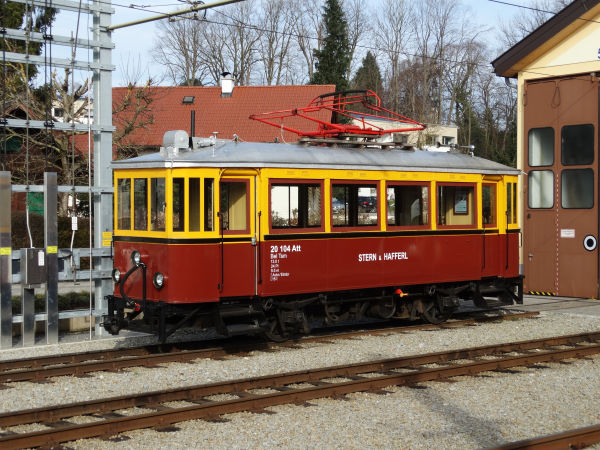
Another view of the same Stern & Hafferl wagon ET 20.104 as above.
Picture at Attersee 15.3.2018 by Ilkka Siissalo.
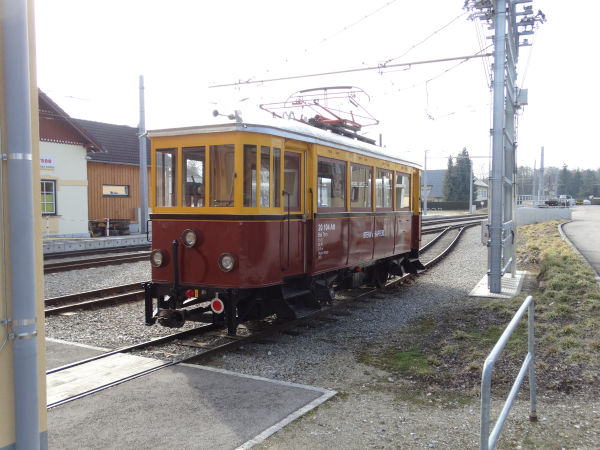
Still another view of the same Stern & Hafferl wagon ET 20.104 as above.
Picture at Attersee 15.3.2018 by Ilkka Siissalo.
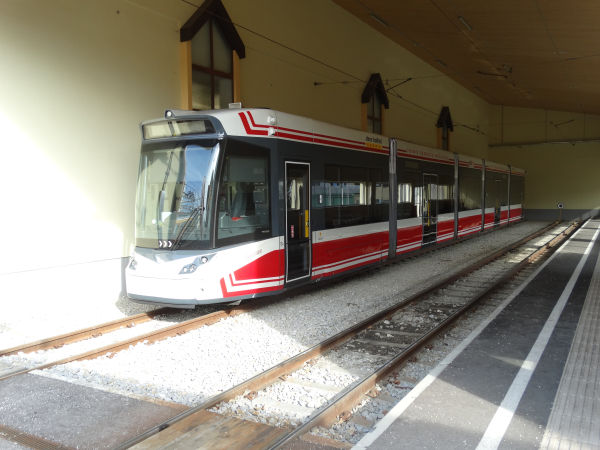
This kind of modern trams take care of all passenger traffic on the Atterseebahn today. They were built by Vossloh Kiepe in 2016. At Atterseebahn
Stern & Hafferl has three of them, numbers 124 (this one, named Attersee), 125 (named St. Georgen) and 126 (named Vöcktlamarkt).
They are of the Vossloh type called Tramlink, 32 metres long and 2,4 metres wide and have place for 183 passengers.
Picture at Attersee 15.3.2018 by Ilkka Siissalo.
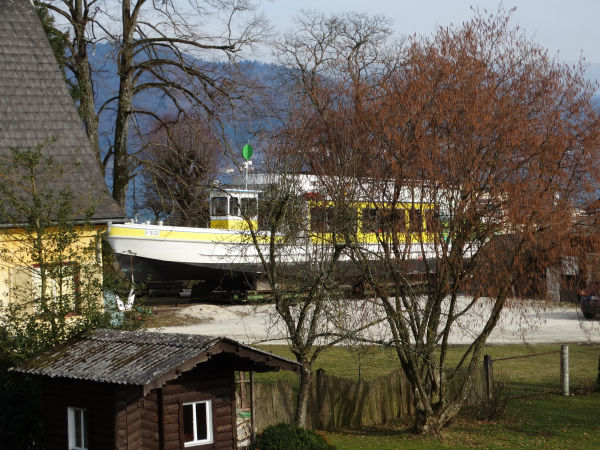
This old ship "O-10.332" is used by Stern & Hafferl during summer months to circulate tourists which the Atterseebahn has brought in to the area
along the beautiful Attersee lake.
Picture at Attersee 15.3.2018 by Ilkka Siissalo.
Stern & Hafferl, Linzer Lokalbahn LiLo

In Linz they have the LILO or Linzer Lokalbahn, a train company of which the city of Linz owns a majority, but which is operated by the company
Stern & Hafferl. This train in the picture is an old LILO train from the 1950s, no more in regular use. This train ET 22.135 was built by Westwaggon
in 1953 or 1954 for the KBFE where Stern & Hafferl bought it used.
Photo 2.1.2003 at the Linz LILO station by Ilkka Siissalo.

The current LILO trains are of the type GTW 2/6 built by Stadler in Switzerland. This one is the GTW no. 22155 at the Linz LILO station by the side
of the old 1950s model 3.1.2003. Photo by Ilkka Siissalo.
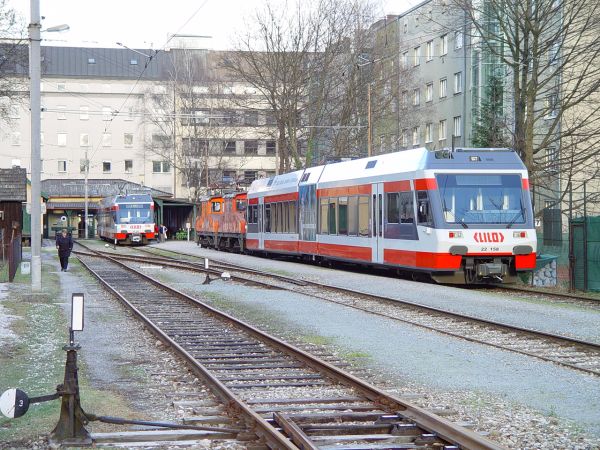
The Linz LILO station with two of the new Stadler GTWs and two old electric locomotives. Photo 3.1.2003 by Ilkka Siissalo.

One of the new Stadler GTW trains of LILO, the ET22.156 is here stopping at Linz Hauptbahnhof (main station). Since the previous pictures
were taken, LILO's route now extends from the old LILO Bahnhof over to the main station and beyond.
Picture from Linz Hauptbahnhof 15.3.2018 by Ilkka Siissalo.
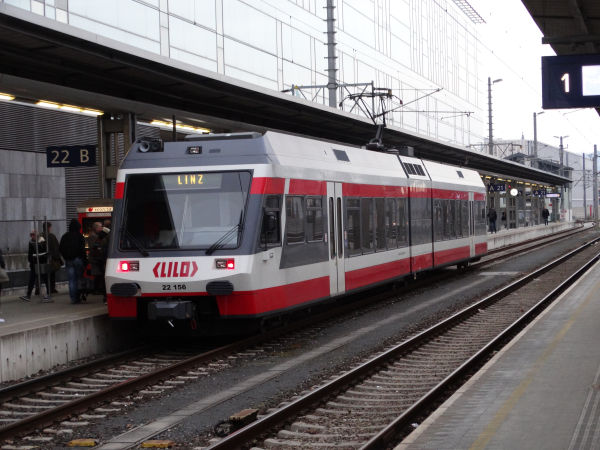
Another view of the same Stadler GTW train ET22.156.
Picture from Linz Hauptbahnhof 15.3.2018 by Ilkka Siissalo.

LILO class E22 locomotive no.5. It was built by Ganz & Co. in 1915. Top speed is 40 km/h. It used to be the "Wöllersdorf II" before World War I.
Photo 3.1.2003 at the Linz LILO station by Ilkka Siissalo.
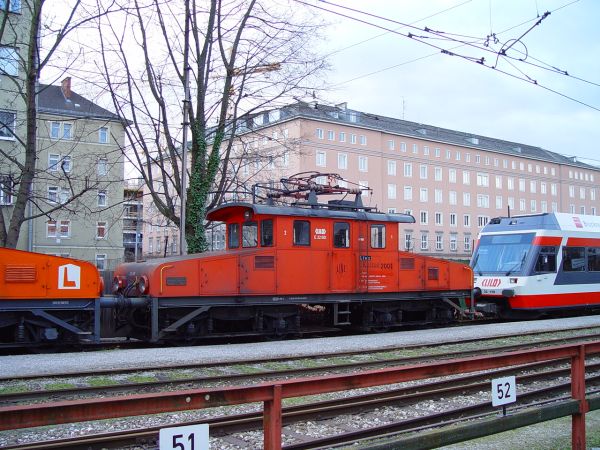
LILO class E22 locomotive no.1. Both this one and the sister locomotive no.5 shown above are from the year 1915, but still occasionally used in
cargo traffic. Photo 3.1.2003 at the Linz LILO station by Ilkka Siissalo.
Stern & Hafferl, Lokalbahn Gmunden - Vorchdorff AG / Traunseebahn
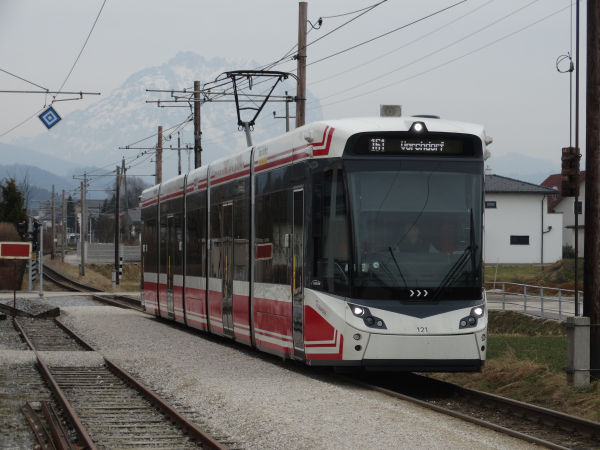
The Traunseebahn, also known as the Lokalbahn Gmunden - Vorchdorff AG, is a narrow gauge line from the city of Gmunden to Vorchdorff on the rural
area. The line was opened in 1912 and is electrified with 750V DC and is 14,7 km long. Today traffic is handled with trams using mostly modern
Vossloh Kiepe trams like this one. They were taken in use in 2016.
Picture from the Kirchham tram stop 15.3.2018 by Ilkka Siissalo.
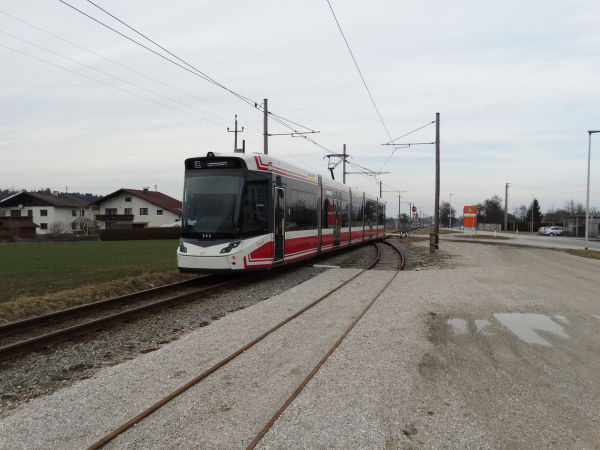
Modernisation of the old narrow gauge train line to a modern tram line was performed in 2013-16. These new Vossloh Tramlink trams were taken
in use 2016.
Picture from the Kirchham tram stop 15.3.2018 by Ilkka Siissalo.

Three of the new Vossloh Tramlink trams at the Vorchdorf station. On the left normal gauge older trains of Stern & Hafferl.
Picture at Vorchdorf 15.3.2018 by Ilkka Siissalo.
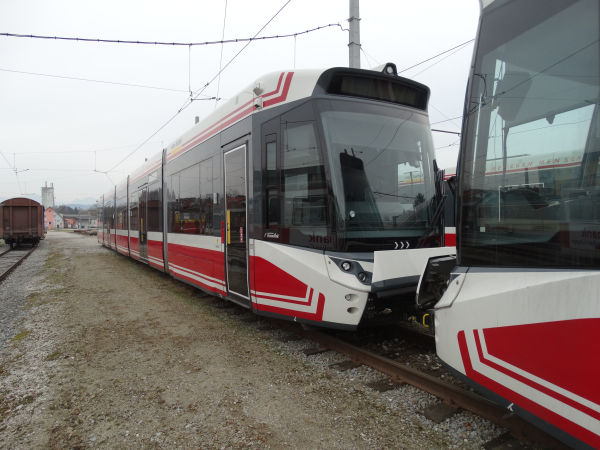
Two of the new Vossloh Tramlink trams can be coupled together to form a really long train when needed. Here units no. 127 and 128.
Picture at Vorchdorf 15.3.2018 by Ilkka Siissalo.
Stern & Hafferl, Lokalbahn Lambach–Vorchdorf-Eggenberg / Vorchdorferbahn
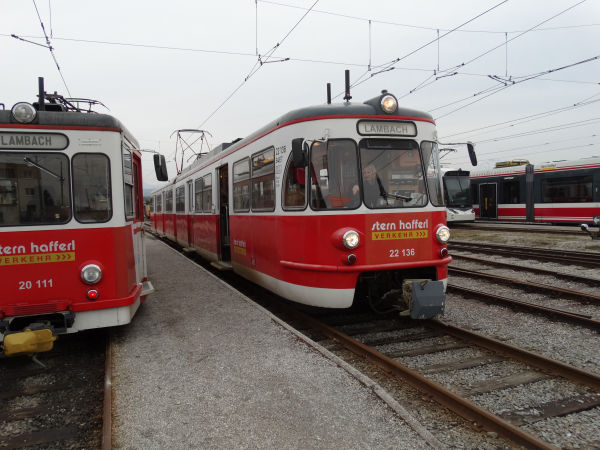
The Vorchdorferbahn is a 15 km long normal 1435 mm gauge private railway operated by Stern & Hafferl. It runs from Lambach, where there is a
connection to the state railways ÖBB's Westbahn line between Linz and Salzburg, to Vorchdorf. Vorchdorf is the centre of operations and
service site of Stern & Hafferl, where both the normal gauge Vorchdorferbahn and the metre gauge Traunseebahn have their trains serviced.
These two old types take care of the passenger traffic on the Vorchdorferbahn today. The articulated tram-train ET22.136 was built by
Westwaggon in 1953. It used to run on the Linzer Lokalbahn LiLo earlier. The other one, ET20.111 is also from Westwaggon and from the year
1953. In fact in 2018 Stern & Hafferl has no train newer than from 1956 on its Vorchdorferbahn line. The line is electrified with 750V DC.
For the future there is a plan to buy new trains capable of running not only on the 750V DC current but also with normal 15 kV AC to allow
the service to be extended along ÖBB lines further on.
Picture from Vorchdorff 15.3.2018 by Ilkka Siissalo.

The tram-train E22.136 is leaving Vorchdorf on its service towards Lambach. This train was built by Westwaggon in 1953 for the German
private railroad Köln-Frechen-Benzelrather Eisenbahn KFBE. Stern & Hafferl bought three of them used when KFBE's services were integrated into
the city of Köln's tram system. These were then used for a long time at Linzer Lokalbahn LiLo and after LiLo finally got new Stadler GTW trains,
they were moved to Vorchdorferbahn.
Picture from Vorchdorff 15.3.2018 by Ilkka Siissalo.
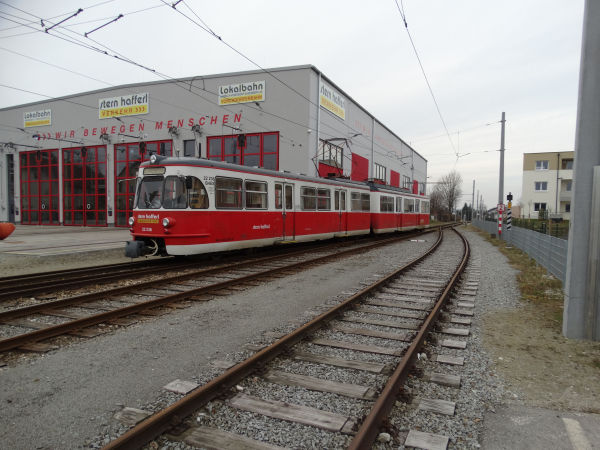
There the tram-train E22.136 goes towards Lambach. In the background the service hall of Stern & Hafferl. On the left there are metre gauge
tracks for the modern Vossloh trams of Traunseebahn and on the right the tracks are normal gauge for the older trains of Vorchdorferbahn.
Picture from Vorchdorff 15.3.2018 by Ilkka Siissalo.

This ET20.111 was built by Westwaggon in 1953. It was built for the Extertalbahn in Germany, near the city of Hannover, where Stern & Hafferl
bought it used in 1969 after passenger traffic on the Extertalbahn had ended. Today the train is only slightly modernised and still in daily use.
Picture from Vorchdorff 15.3.2018 by Ilkka Siissalo.
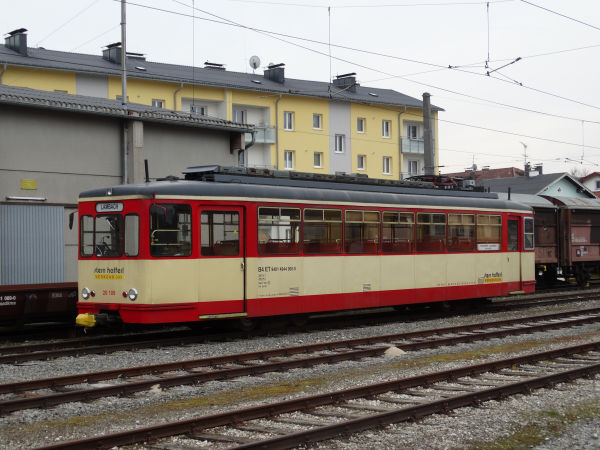
This ET20.109 is outwardly fairly similar to the ET20.111 pictured above, but it is still in its older paintings. It is similar, but a lot older.
This one was built by Grazer Waggonfabrik already in 1908 for the Lokalbahn Neumarkt–Waizenkirchen–Peuerbach. Stern & Hafferl took over that
railroad from kkStB (that time state railways) in 1913. In those days the wagon had a chassis made from wood. Nowadays this wagon is used as a
museum train on the Vorchdorferbahn line.
Picture from Vorchdorff 15.3.2018 by Ilkka Siissalo.
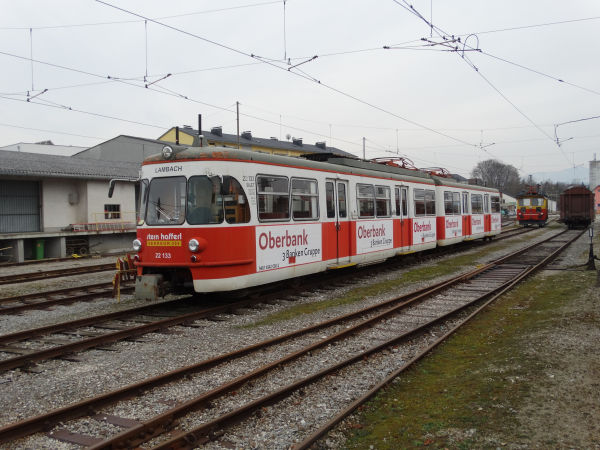
The ET22.133 was also built by Westwaggon in 1953 and it also was bought used from the Köln-Frechen-Benzelrather Eisenbahn KFBE. Today it's already
fairly badly rusted. No wonder, taking its age into account.
Picture from Vorchdorff 15.3.2018 by Ilkka Siissalo.
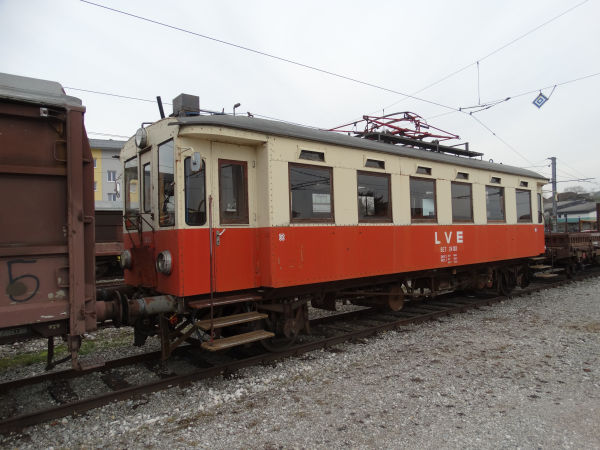
ET24.103, previously ET 23.003 was built by Grazer Waggonfabriek in 1912. It is classified today as "Nostalgiefarhzeug", nostalgy train.
The text LVE on its side refers to Lokalbahn Lambach–Vorchdorf-Eggenberg, which is another name for the Vorchdorferbahn.
Picture from Vorchdorff 15.3.2018 by Ilkka Siissalo.
Westbahn
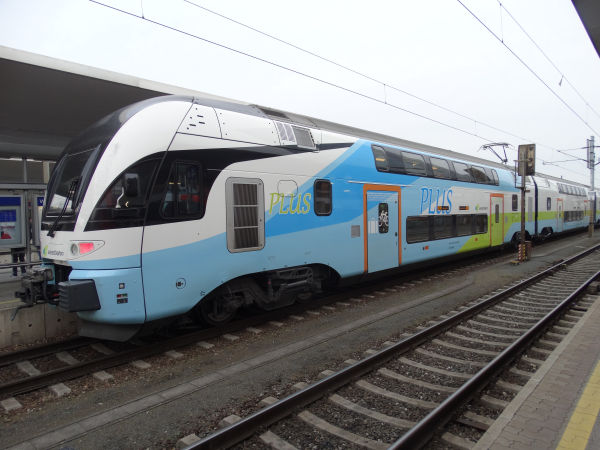
Westbahn is a private express train operator, which since December 2011 runs express trains on the Westbahn line between Wien and Salzburg
in direct competition against state railways ÖBB. Westbahn uses double decker trains of the type KISS made by Stadler of Switzerland. In the
beginning the finances of Westbahn werein a bit of a dubious state, but recently Westbahn had to even order 10 more trains because of the
growing passenger numbers. This is one of the second batch KISS trains, recognizable especially from the new doors, redesigned to better
withstand rapid air pressure changes when two fast trains pass each other in a tunnel. The front windscreen windows of this second batch
are also slightly smaller than in the first Westbahn KISS trains. The first batch seven KISSes were six coaches long. Out of the second batch
of ten more trains, nine are only four coaches long - just like this one - and one is six coaches long.
French state railways SNCF owns now 26% of Westbahn.
Picture from Linz station 15.3.2018 by Ilkka Siissalo.
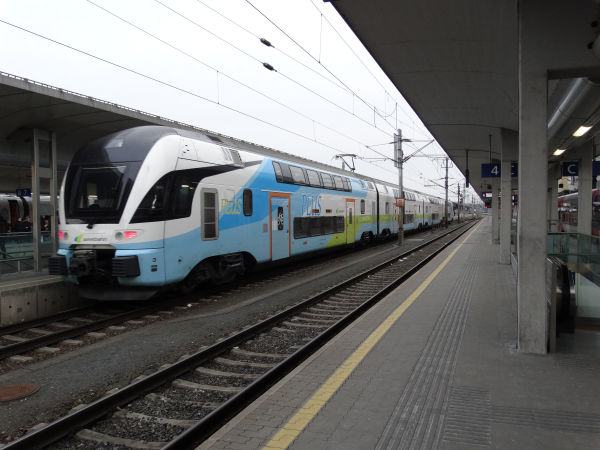
The same Westbahn KISS as in the picture above, now leaving towards Salzburg.
Picture from Linz station 15.3.2018 by Ilkka Siissalo.

Another Westbahn KISS train, but now this one is one of the first production batch six coach units. Look at the doors and compare them with
the second production series trains' doors shown above. In the picture background another Westbahn KISS, but with the new doors. This unit in our
picture has already received a new and smaller windscreen window. Westbahn was complaining that on the route which has a lot of tunnels, fairly
often dropping ice or small stones damage the trains' windscreen windows. In the original design they were glued and replacing a windscreen meant
that the whole train had to be out of use for a full 24hr. With the new design with smaller windscreens the glasses are fixed with screws and can
be changed within about an hour. Westbahn decided to change all the windscreens to this newer type and apparently at this train the change has
already been made.
Picture from Salzburg Hauptbahnhof 14.3.2018 by Ilkka Siissalo.
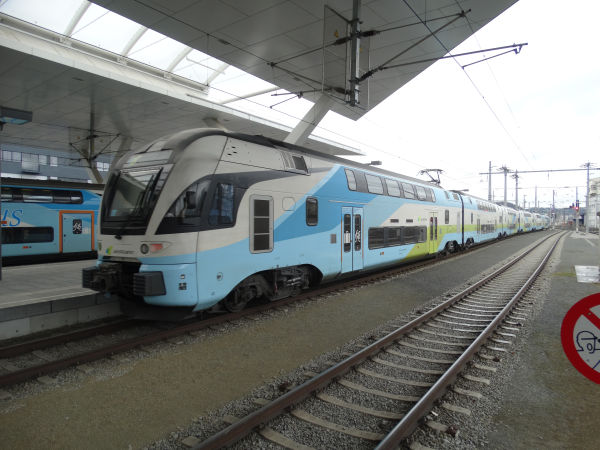
The same Westbahn KISS of the first production series as in the picture above, with six coaches is here leaving Salzburg towards Wien. This type
of doors, originally designed for regional trains, caused discomfort for passengers when a RailJet or other similar fast train is passing at
close distance in a tunnel. Air pressure change causes these doors to bang in an unpleasant way. Therefore the newer 10 KISSes of Westbahn have
totally different doors.
Picture from Salzburg Hauptbahnhof 14.3.2018 by Ilkka Siissalo.
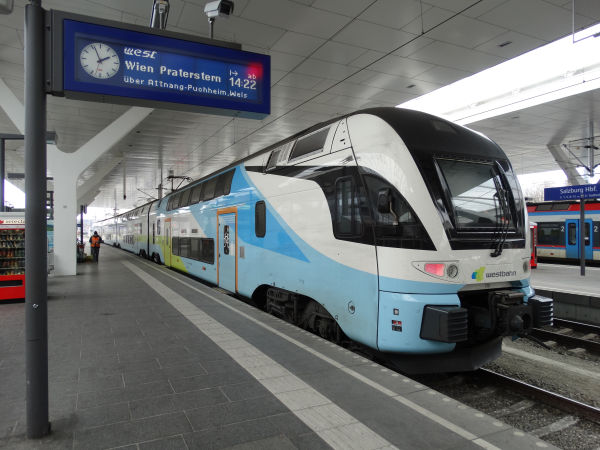
One of the new, second series Westbahn Stadler KISS trains waiting for its departure time at Salzburg Hauptbahnhof. Note the new doors, just
four coaches and from this angle it's also possible to see that the windscreen glass is fitted with screws.
Picture from Salzburg Hauptbahnhof 14.3.2018 by Ilkka Siissalo.
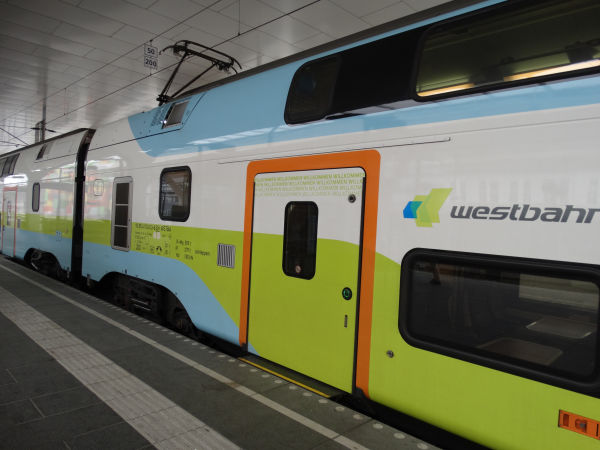
The new, tighter door of a 2. series Westbahn KISS. Especially older people did not recognise it as a door, so Westbahn had to mark the
doors with orange colour.
Picture from Salzburg Hauptbahnhof 14.3.2018 by Ilkka Siissalo.
Zillertalbahn

The Zillertalbahn (Ziller valley railway) is a 32 km long 760 mm gauge narrow gauge railway running from Jenbach to Mayrhofen.
It still serves local, rural people in their daily transportation needs, but it is also a famous touristic attraction with its
steam engine driven museum trains. Normal daily train operation in Zillertal is done much in the same way as at the Pinzgauer Lokalbahn,
which is portrayed earlier on this page. This is a Zillertalbahn Gmeinder locomotive, number 84, similar to the Pinzgauer machines.
It is here being serviced at the SLB depot at Tischlerhäusl, which is the center of operations of the Pinzgauer Lokalbahn of SLB.
Picture from Tischlerhäusl by Zell am See 14.3.2018 by Ilkka Siissalo.

